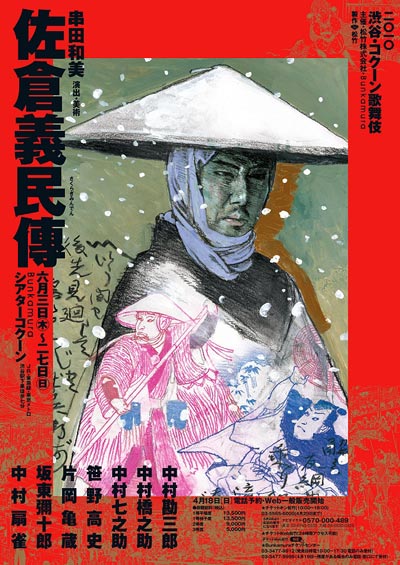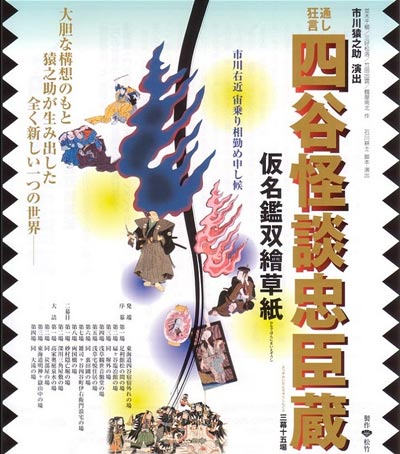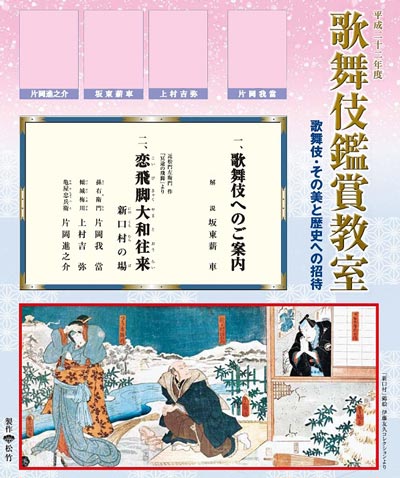| Comments |
Ono no T˘fű: Ono no T˘fű is famous as one of the greatest calligraphers
in the history of Japan and legend has it that he was inspired by the sight of a
frog jumping onto a tall willow tree in the rain. This image has made it onto
a hanafuda card and was a stock story of pre-war moral education.
This month there is a very rare performance of a play that shows
Ono no T˘fű not only as a great calligrapher, but also as a powerful fighter.
After elegant court noble Ono no T˘fű (Nakamura Baigyoku) witnesses this scene, he fights with
Daroku (Nakamura Kanjaku) a red-faced warrior like a sum˘ wrestler.
The two unlikely combatants are evenly matched and this fight is an omen of
disturbances in the land and the two joining forces to bring peace.
Momijigari: the general Taira Koremochi (Ichikawa Somegor˘) travels to the mountains to view the
autumn leaves when he suddenly encounters a beautiful princess (Nakamura Fukusuke) and her entourage.
Aided by the elegant dancing of the princess and a large amount of sake, Koremochi falls asleep,
not knowing that she is actually a fierce demon. The god of the mountain (Onoe Sh˘roku)
dances vigorously to try to wake up Koremochi. But as the demon appears in its true form,
Koremochi is saved by the magical power of his sword.
Ishikawa Goemon: in the time of the warlord Toyotomi Hideyoshi, Ishikawa Goemon was a famous
larger-than-life thief. When he was executed by being boiled alive, he is said to have
defiantly said that the sands on the beach may run out but thieves will never disappear from this world.
In this play, a rare revival, Goemon hides in a giant basket, which then flies through the air.
As the basket goes to the ceiling of the theater, suddenly Goemon burst out and travels triumphantly through the sky.
This production stars Nakamura Kichiemon as Ishikawa Goemon. Featuring also Nakamura Baigyoku, Nakamura Karoku and Nakamura Kash˘.
Shiokumi: in the classical N˘ Theatre, there are few plays as
evocative as Matsukaze, the story of a court noble exiled to the seacoast where he
falls in love with two fisher women. The women make their living scooping up heavy
buckets of sea water to make salt and this has become a famous dance.
Starring Sakata T˘jűr˘ as the shiokumi Matsukaze.
ďkawa no Inkyo: Onihei Hankach˘ is a popular series of novels, written by Ikenami Sh˘tar˘ from 1967,
and successfully adapted to television. In all, 135 stories were published. The hero is Hasegawa
Heiz˘, head of the special police who had jurisdiction over arson and robberies in Edo. His nickname is "Onihei," which means "Heiz˘ the Devil".
He leads a band of law-enforcers and cultivates reformed criminals as informants to solve difficult crimes. This episode, "The Retired of the ďkawa River"
is about the stealing of Onihei's precious silver kiseru, a souvenir from his late father.
The investigations lead Onihei to the old boatman Tomogor˘, who used to be a thief but he's supposed to have retired.
Featuring Nakamura Kichiemon and Nakamura Karoku in the roles of Onihei and Tomogor˘.
Featuring also Nakamura Baigyoku, Nakamura Fukusuke, Nakamura Kash˘ and Ichikawa Somegor˘.
Kezori: one of the most spectacular plays in Kabuki, "Kezori" shows
a man who has grown wealthy as a smuggler and shows his exotic lifestyle and
expansive spirit. A merchant named S˘shichi (Sakata T˘jűr˘) is in love with a courtesan
named Kojor˘ (Nakamura Fukusuke). He boards a boat unaware that it is owned by the smuggler
Kezori (Nakamura Kichiemon) who is also his rival in love. S˘shichi happens to see illicit
merchandise being unloaded and Kezori has him thrown into the sea.
The boat revolves and Kezori poses on its prow, gazing proudly out at the world
he rules. However, S˘shichi survives and goes to Kojor˘ for help.
She says that she will ask one of her patrons for money and S˘shichi greets
the patron only to find that it is Kezori. Magnanimously, Kezori forgives S˘shichi
and will help him, but on the condition that S˘shichi become a member of his gang.
Featuring also Nakamura Kanjaku, Onoe Sh˘roku, Ichikawa Somegor˘ and Nakamura T˘z˘.
Kioi Jishi: this dance shows an Edo festival with its lively lion
dance and other entertainments. The festival is full of handsome firemen and
attractive geisha who do a series of graceful dances. One of the highlights of
this dance is the story of the Soga brothers avenging the death of their father
by attacking their enemy during a hunting party for the Sh˘gun at the foot of
Mt. Fuji. Featuring Onoe Sh˘roku and Ichikawa Somegor˘.
Source: Earphone Guide website
|




